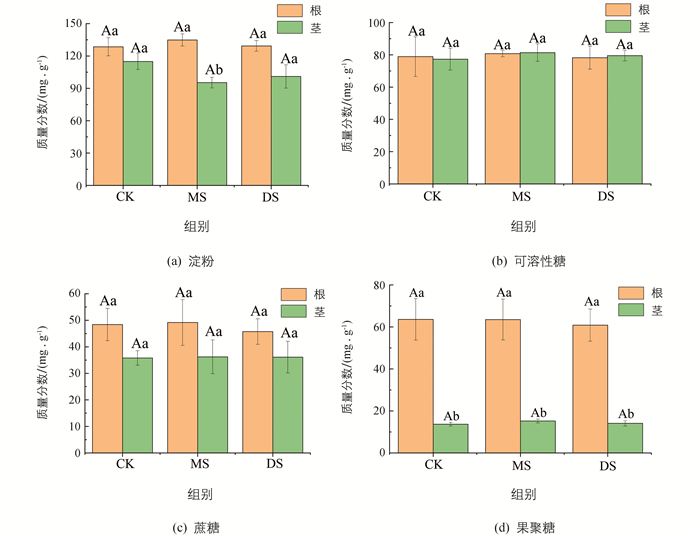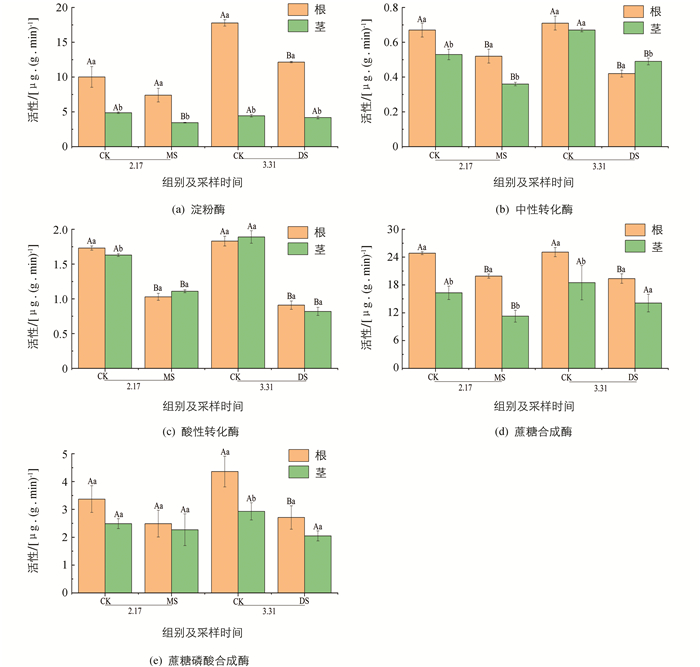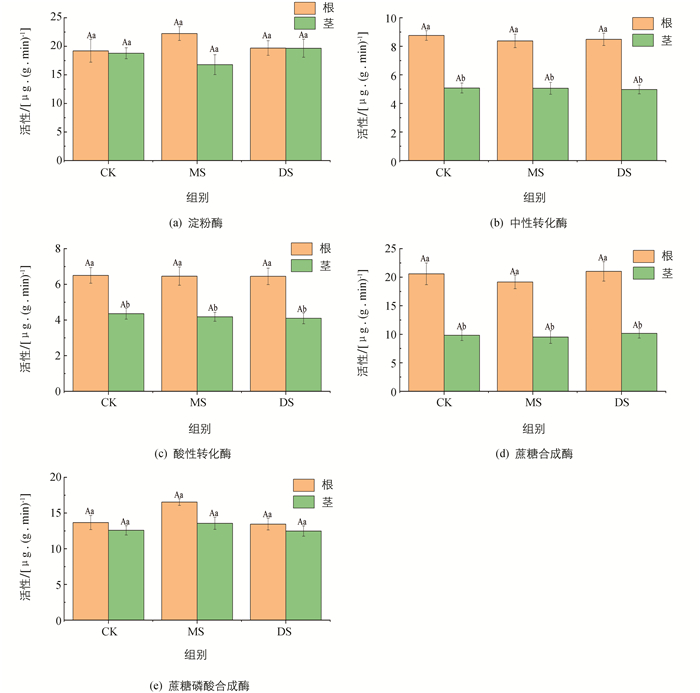-
开放科学(资源服务)标志码(OSID):

-
三峡水库周期性蓄水、泄洪导致库区水位升降所造成的周期性出露水面的区域被称作“三峡库区消落带”[1]. 消落带是一类特殊的湿地生态系统,是陆地生态系统和水生生态系统的过渡带,具有截污过滤、改善水质、控制沉积和减缓侵蚀的功能,并为动植物提供繁殖和栖息的场所[2].
植物是生态系统的重要组成部分,消落带的植被状况直接关系到消落带生态功能的发挥[3-4]. 受三峡库区独特的水文调节方式的影响,消落带原有植物物种难以耐受长时间、高强度的冬季水淹而大量消亡[5],造成了如库岸失稳、水土流失、生物多样性减少等一系列生态问题,也对消落带周边居民的生活与生产造成了严重的影响[6]. 因此,如何治理消落带不仅是三峡库区实现可持续发展的关键一环,也关乎到长江流域的生态安全[7]. 一般认为,选择适生植物对库区消落带进行植被重建是治理三峡库区消落带生态问题最有效且最经济的方法[8-9]. 植被重建的关键是筛选出当消落带水位回落时能耐干旱而在消落带水位回升后能耐长期水淹的两栖植物[5, 10-13]. 现已有大量研究人员通过模拟不同环境条件,筛选出了一批在消落带复杂多变的生境条件下生长表现良好的物种,如池杉(Taxodium ascendens)、立柳(Salix matsudana)、狗牙根(Cynodon dactylon)等并开展了原位示范研究[14-19]. 对示范区重建植被多年追踪观测发现,部分在模拟水淹研究中表现良好的物种当再次经历三峡库区消落带水位周期性变化后出现大面积死亡的现象,对耐淹物种的适应性及适应机理仍需要进一步探究.
水淹造成植物的生长环境从有氧变为缺氧,存留的适生植物主要靠糖酵解等无氧代谢途径获取能量,以维持植物在水淹缺氧环境下的各项生理功能[20-22]. 水淹可能对糖代谢中涉及的酶活性如淀粉酶、蔗糖合成酶、中性转化酶等产生重要影响[23],改变适生植物的碳水化合物代谢特征. 植物体内的碳水化合物可分为结构性碳水化合物(structural carbohydrates,SC)和非结构性碳水化合物(non-structural carbohydrates,NSC)[24-25]. SC包括纤维素、木质素、果胶等,主要用于植物形态的建构[26],为植物耐受逆境提供结构基础. NSC包括葡萄糖、果糖、蔗糖以及淀粉等,关系着植物的代谢、生长和发育[27],其质量分数与分配方式体现了植物在水淹胁迫下的生存策略,也直接影响着植物对逆境的耐受能力[28]. 因此,适生木本植物在水淹期间NSC的代谢特征对于其耐受水淹胁迫的能力极为关键. 作为耐淹性较强的适生木本植物,池杉已被用于三峡库区消落带的植被修复工作中. 本文以重庆市忠县汝溪河流域消落带修复示范基地池杉为例,分析种植于不同高程的池杉植株在一个水淹周期中的NSC代谢差异,以期从能量消耗的角度探索其耐淹机理,为消落带植被修复提供理论和实践指导.
全文HTML
-
试验样地位于三峡库区汝溪河消落带修复示范基地. 汝溪河为长江左岸一级支流,基地位于重庆市忠县石宝镇万松村(30°25′55.47″ N,108°09′59.18″ E),面积约为10 hm2,属亚热带东南季风山地气候,年积温5 787 ℃,年均温18.2 ℃,无霜期341 d,日照时数1 327.5 h,日照率29%,年降雨量1 200 mm,相对湿度80%. 2016年3月,在消落带165~175 m高程种植长势基本一致的两年生池杉(株高约69 cm,基径约8.4 mm)纯林,株行距1 m.
-
根据三峡库区消落带的水位变动规律形成的不同水淹强度,将样地划分为3个样带,设置3个处理. 各处理的基本信息见表 1.
种植的池杉幼苗在经历一个完整水淹周期后,于2017年2月17日(海拔170 m样带退水初期)对175 m和170 m样带的池杉进行随机抽样,2017年3月31日(海拔165 m样带退水初期)对175 m和165 m样带的池杉进行随机取样,2017年9月11日(165 m样带再次水淹前),对175 m,170 m和165 m样带的池杉进行随机抽样. 取样时,在各海拔样带分别选取池杉样木各4株,分别用测高杆和游标卡尺测量植株株高和基径等生长指标,再进行破坏性取样. 取样后,将每个植株根和茎编号后分别装入自封袋,放入冰盒,带回实验室待测.
-
在实验室将取回的池杉根、茎分别取上、中、下3部分鲜样混合,称量后用作酶活性测试. 其余部分称鲜质量后,立即放入80 ℃烘箱中烘干至恒质量后称量,用于计算植株生物量.
本研究中的NSC包括可溶性糖、淀粉、蔗糖和果聚糖. 将烘干后植物样粉碎过100目筛,准确称量0.01 g用于NSC质量分数测定. 其中,可溶性糖和淀粉质量分数的测定采用蒽酮—硫酸比色法[29],蔗糖质量分数的测定采用间苯二酚比色法[30],果聚糖质量分数的测定采用Seli-wanoff法[31].
准确称量0.5 g池杉根、茎鲜样,进行NSC代谢酶活性的测定. 其中,中性转化酶与酸性转化酶用UDPG比色法进行测定,蔗糖合成酶与蔗糖磷酸合成酶用3,5-二硝基水杨酸比色法进行测定[30],淀粉酶的测定参考Mitsunaga等[32-33]的方法.
-
采用统计分析软件SPSS 22.0进行数据处理分析,用独立样本t检验比较退水初期两个处理组之间各项生理指标的差异; 用配对样本t检验比较同一处理组在不同采样时间下及同组植株不同器官间各项生理指标的差异. 用单因素方差分析法分析恢复生长末期各处理植株间生长指标的差异,采用Tukey多重比较检验各处理植株间的差异; 采用Origin2018软件制图.
1.1. 试验样地概况
1.2. 试验设计及取样
1.3. 测定指标及方法
1.4. 数据分析方法
-
表 2为3次采样时各处理组生长指标(株高、基径和干质量)的对比情况. 从整体上看,在退水初期,与对照组植株相比,2个水淹组植株的株高、基径和干质量均有所降低. 独立样本t检验结果显示,植株株高与基径在各处理组之间差异无统计学意义,而对照组的干质量均显著大于水淹组(p<0.05),说明受冬季水淹的影响,池杉的生长受到了不同程度的抑制.
经过半年的恢复生长,在生长末期,各处理组的各项生长指标相较于退水初期均有不同程度的上升. 除重度水淹组的基径外,水淹组的株高和基径与对照组相比差异无统计学意义(p>0.05),基本恢复到与对照组同一水平,但干质量仍显著低于对照组(p<0.05).
-
图 1为退水初期各处理组植株根与茎NSC质量分数对比图. 配对样本t检验结果显示,各处理组池杉根中淀粉、可溶性糖(3月31日取样CK组除外)和果聚糖质量分数均显著大于茎中质量分数(p<0.05),而根、茎蔗糖质量分数差异无统计学意义.
整体而言,与对照组相比,2个水淹组池杉根与茎中的NSC质量分数均表现出不同程度的降低. 但统计检验结果显示,仅中度水淹组植株根中的淀粉质量分数、茎中可溶性糖质量分数显著低于对照组(p<0.05).
图 2是恢复生长末期各处理组池杉根与茎NSC质量分数对比图. 单因素方差分析及结果显示,4种NSC组分质量分数的组间差异无统计学意义,说明经过一个完整的恢复生长期,水淹组池杉已经恢复到了对照组水平.
各处理组中的4种NSC组分质量分数在植株根与茎间的分布特征呈现出相似的规律. 池杉根中果聚糖质量分数显著高于茎中质量分数(p<0.05),中度水淹组根中淀粉质量分数显著高于茎中质量分数(p<0.05),其余指标在根与茎之间差异无统计学意义.
与退水初期相比,2个水淹组池杉根、茎中NSC质量分数在恢复生长末期均有不同程度的增加(表 3). 其中,中度水淹组除茎中的蔗糖质量分数及根中的果聚糖质量分数外,其余指标差异均有统计学意义(p<0.05). 冬季水淹后,2个水淹组池杉根中可溶性糖质量分数均高于茎中质量分数,但是经过恢复生长后,可溶性糖质量分数在根、茎之间呈现出平均分布的特征.
-
图 3为退水初期各个处理组池杉根与茎中的NSC代谢酶活性. 从整体上看,池杉根的代谢酶活性高于茎. 配对样本t检验结果显示,各处理组根中的淀粉酶和蔗糖合成酶(3月31日重度水淹组除外)活性均显著高于茎(p<0.05); 中度水淹组的中性转化酶在根中的活性显著高于茎,但是在重度水淹组中却相反,茎中的中性转化酶活性显著高于根; 3月31日采样时对照组根中的蔗糖磷酸合成酶显著高于茎. 中性转化酶,酸性转化酶,2月17日采样的蔗糖合成酶和茎的淀粉酶,3月31日采样的根的淀粉酶、根的蔗糖合成酶、根的蔗糖磷酸合成酶在水淹组中的活性均显著低于对照组中的活性(p<0.05).
图 4为恢复池杉在生长末期根与茎的NSC代谢酶活性. 由配对样本t检验结果可以看出,中性转化酶、酸性转化酶和蔗糖合成酶3种酶在根与茎中的活性表现差异有统计学意义(p<0.05),均表现出根显著大于茎的特征,而淀粉酶、蔗糖磷酸合成酶在根与茎中的活性差异无统计学意义. 由单因素方差分析结果可以看出,测得的5种NSC在不同处理组之间差异无统计学意义,说明在恢复生长期,水淹组与对照组池杉的NSC代谢酶活性基本处于同一水平,水淹组池杉的淀粉和蔗糖代谢强度与对照组基本一致.
2.1. 池杉生长状况的变化
2.2. 池杉根、茎NSC质量分数的变化
2.3. 池杉NSC代谢酶活性的变化
-
植物体外部形态如株高、基径、生物量等的改变在很大程度上是对环境条件适应的结果[34-35],其变化趋势与幅度可以直观地反映该种植物对于特定环境条件的适应能力与方式,同时也可以反映植物体在逆境条件下的生存策略[36]. 植物对水淹胁迫的适应策略包括逃避策略和忍耐策略[37]. 当植物采取逃避策略时,会加速消耗NSC来促进茎部的生长,使植物的顶部能够露出水面,从而缓解缺氧带来的胁迫压力[37]. 但是当植株受到水淹胁迫强度(水淹深度、水淹时间)过大时,加速NSC的消耗并不利于植株的生存[38]. 在这种情况下,植物会选择忍耐策略,通过减少能耗使生长最小化来留存尽可能多的NSC,以保证存活[38]. 在本研究中,冬季水淹不同程度地抑制了池杉株高和基径的增长,水淹组植株干质量显著性降低,池杉采取了“忍耐”策略,将能量更多地投入到生理代谢而非生长中,仅保证最低能量供应从而最大化地保证顺利度过长时间高强度的水淹期. 退水后的快速再生能力表明池杉具有良好的耐淹适应性.
在植物体中,淀粉质量分数的高低反映了植物可供使用能量的多少[39-40],而淀粉水解与蔗糖降解所产生的葡萄糖和果糖是植物无氧呼吸糖酵解途径的底物,因此淀粉与蔗糖的质量分数与正常代谢对于植物在水淹环境下的存活至关重要. 在冬季水淹期间,淀粉主要分布于池杉根部,而不同强度的水淹胁迫显著降低了池杉根中的淀粉质量分数. 这与水淹胁迫下池杉的光合作用受到限制、淀粉的生产被终止有关. 为保证水淹下植株必需的能量供应,池杉根部的淀粉被淀粉酶分解成无氧呼吸所需要的葡萄糖与果糖. 在不同强度水淹条件下,池杉根茎中的淀粉酶活性均呈现出不同程度的降低,且表现为根中的活性显著大于茎中的活性的特征. 说明在水淹胁迫下,为了顺利度过长时间高强度的水淹胁迫,水淹组池杉降低了淀粉的代谢强度,为退水落干后的恢复生长期保留了尽可能多的能量储备.
植物的可溶性糖为植物无氧呼吸糖酵解的底物[26, 41-42]. 在水淹条件下,植物严重缺氧,能量供应主要来自于无氧呼吸,可溶性糖质量分数对植株能否存活至关重要[23]. 研究结果显示,各水淹组池杉在退水初期的可溶性糖质量分数均低于对照组,说明在水淹胁迫下,植株的供能方式以无氧呼吸为主,消耗了植株体内更多的可溶性糖. 值得注意的是,中度水淹组池杉茎的可溶性糖显著低于对照组,而根中的可溶性糖质量分数差异无统计学意义,这可能与池杉重新分配了根茎中可溶性糖的质量分数有关,将可溶性糖更多地储存在根中,以提高对胁迫生境的耐受能力. 同时,可溶性糖是植物细胞渗透压调节物质,适当减少茎中可溶性糖的质量分数可以调节植物细胞的渗透压,降低水淹胁迫的危害[23],也是池杉在水淹胁迫下的保护措施.
蔗糖是植物体内碳水化合物的主要运输物质,为植物生长提供能量,还可以调节细胞的渗透压以维持水淹胁迫下植物细胞的完整性[43]. 与淀粉的分配方式不同,蔗糖在池杉根与茎之间的分配差异无统计学意义,且不同强度水淹组植株蔗糖质量分数与对照组差异无统计学意义. 原因可能是池杉在遭受水淹胁迫的前期,蔗糖质量分数会通过果聚糖的降解得到补充,而在水淹胁迫的后期,池杉的蔗糖代谢强度降低,从而保持了相对稳定的蔗糖质量分数.
淀粉和蔗糖是植物光合作用的主要产物,负责调控蔗糖与淀粉代谢的蔗糖磷酸合成酶、蔗糖合成酶、中性转化酶、酸性转化酶与淀粉酶对于植物体的生理活动能否顺利进行至关重要[44]. 其中,蔗糖磷酸合成酶是植物体内控制蔗糖合成的关键酶,它的活性反映了植物体内蔗糖合成的能力; 蔗糖合成酶既调控蔗糖的合成也调控蔗糖的分解,与转化酶(中性转化酶与酸性转化酶)共同调控蔗糖的降解[45]; 淀粉酶则直接催化淀粉的分解[44]. 所以,代谢酶的活性也从另一个角度反映了植物在适应水淹环境中的调度策略. 在本研究中,与对照组相比,4种蔗糖代谢酶在水淹组中的活性均有不同程度的降低. 其中,中度水淹组池杉蔗糖磷酸合成酶质量分数虽有降低,但与对照组差异无统计学意义,而重度水淹组池杉的蔗糖磷酸合成酶活性出现显著性降低的特征. 这说明随着水淹胁迫强度的增加,葡萄糖主要被用于无氧呼吸的糖酵解中,蔗糖主要合成途径所需的底物受限,相对应的催化剂活性也随之降低. 作为另一条蔗糖合成途径的催化剂,蔗糖合成酶可以催化蔗糖与二磷酸尿苷(uridine diphosphate,UDP)生成果糖与二磷酸尿苷葡萄糖(uridine diphosphate glucose,UDPG)之间的可逆反应,可以使蔗糖快速地在“源”与“库”之间转换,但通常认为该途径的主要作用是分解蔗糖[46]. 中性转化酶与酸性转化酶则是两种负责蔗糖分解的代谢酶. 在本研究中,水淹组池杉蔗糖合成酶、中性转化酶与酸性转化酶活性在水淹期间均有显著的降低,原因可能是在保证基础能量消耗的条件下,池杉通过降低蔗糖代谢的强度来保证植株体内的蔗糖质量分数维持在相对稳定的水平.
果聚糖主要存在于植物体的液泡中,对于植物耐受干旱、水淹、盐碱等非生物胁迫有着重要作用. 高等植物果聚糖以蔗糖作为底物合成,其降解过程是逐步将末端果糖解离下来,最终留下的蔗糖分子可通过转化酶进一步水解[47-48],所以果聚糖的稳定降解对于水淹下植物的能量代谢也十分重要. 在本研究中,各处理组池杉根中的果聚糖质量分数均显著高于茎. 与对照组相比,中度水淹胁迫组池杉果聚糖质量分数整体呈现出上升的趋势,而重度水淹胁迫组则呈现出下降的趋势. 原因可能是在受到水淹胁迫的早期,果聚糖在植物体内积累,以维持细胞结构的稳定,这与Albrecht等[44]的实验结果一致; 但随着胁迫强度增大,池杉为了维持蔗糖质量分数的相对稳定,将果聚糖从积累逐渐变成降解,以维持池杉的正常代谢水平.
对于受周期性水淹胁迫的植物而言,退水后的恢复生长期至关重要,植株需要在此期间积蓄能量,以应对下一个周期的水淹胁迫. 研究结果显示,相比于退水初期,各水淹处理组在恢复生长末期的NSC质量分数、淀粉酶和蔗糖代谢相关酶的活性均有不同程度的升高,并与对照组保持在相同水平,差异无统计学意义. 经过退水落干后的恢复生长期,水淹组池杉的NSC均能够恢复到与对照组相同的水平,为应对下一个水淹周期的到来做好了物质准备.
-
本研究从NSC代谢的角度初步探究了池杉适应三峡库区消落带生境水位变动的机理. 池杉在水淹期间采用“忍耐”的生存策略,将NSC更多地投入到生理代谢而非生长中,表现出对水淹良好的适应性. 在退水后的恢复生长期,池杉通过提高生长代谢的强度与能量物质的积累快速蓄积能量,从而得以顺利进入下一个水淹周期.




 下载:
下载:


